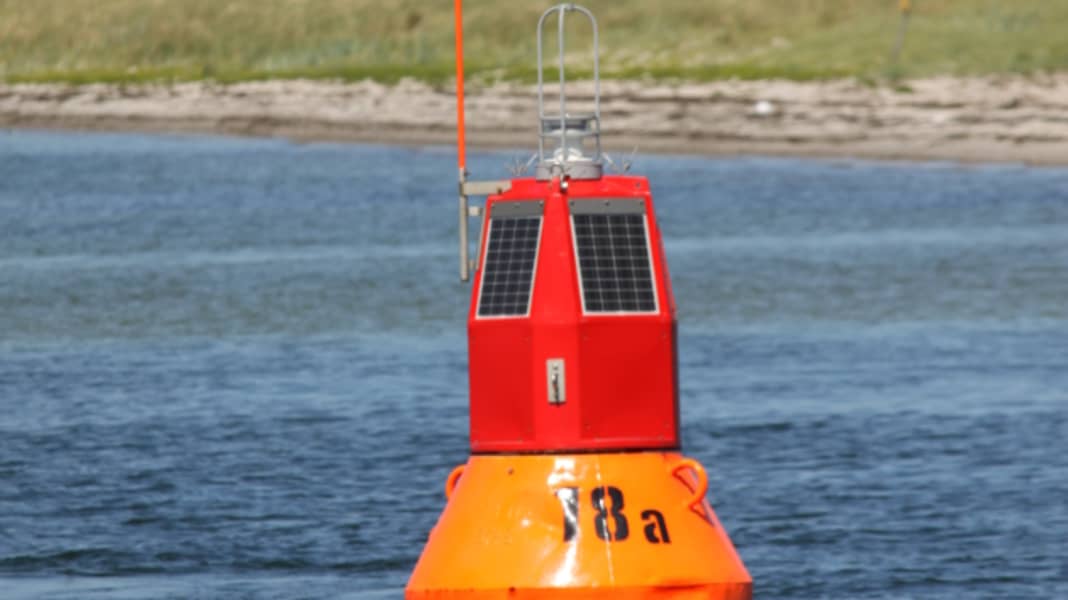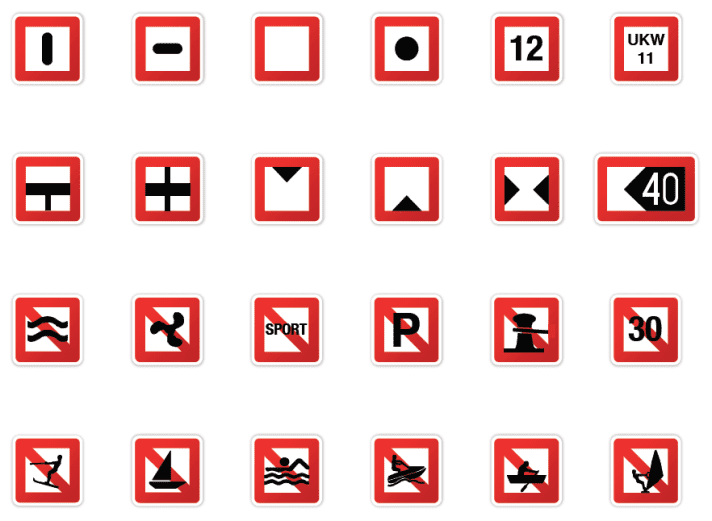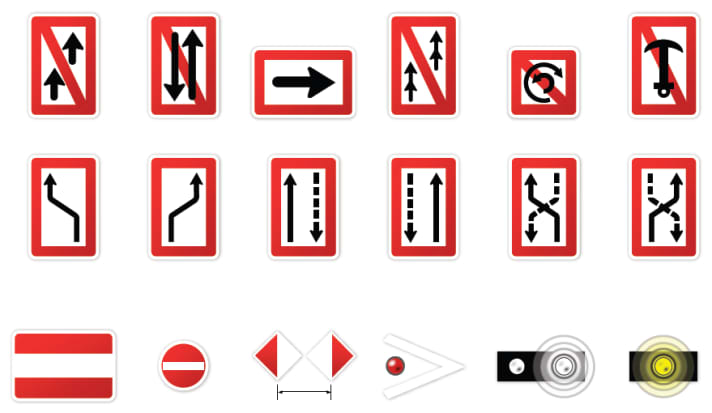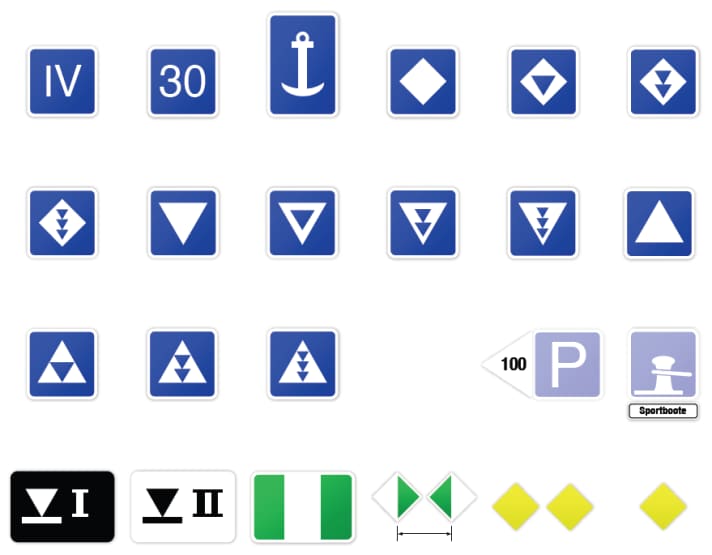
The traffic signs on the waterways are called navigation signs and indicate (with more or less clear symbols) what is permitted, required or prohibited where. There are also individual, official notices in the form of signs, which should of course also be observed. The signs do not always have to be on the shore; they can also be on the water surface itself - either mounted on buoys or on a fixed pole or dolphin. Furthermore, it does not necessarily have to be a metal sign; painted signs, for example on bridges or quay walls, are just as obligatory.
On this page you will find all the navigation signs of the Inland Waterways Ordinance. For the complete designations and the underlying paragraphs, please refer to the ordinance itself. The three navigation police regulations for the Rhine, Moselle and Danube each have a few additional signs, but these are very rare.
The opposite is true on maritime waterways - the signs there also have the same appearance, but there are far fewer of them. The colour red indicates commands and prohibitions, while the colour blue indicates recommendations and permissions.
Incidentally, not all navigation signs also apply to small vessels, but you should still be familiar with them so that you know how the "big ones" should behave.
Table 1: Commandments and prohibitions

1st row (from left to right)
- Special care
- Stop
- Shipping restrictions
- Give a sound signal
- Maximum speed (in km/h)
- Put the radio into operation on the displayed channel
2nd row (from left to right)
- Confluent waterway
- Crossing waterways
- Limited headroom
- Limited water depth
- Limited width of passage or fairway
- Maintain distance (in metres) from the sign
3rd row (from left to right)
- Avoid suction and wave impact
- Vehicles with engine drive prohibited
- Sports vehicles prohibited
- No mooring (anchoring and mooring on the shore)
- Ban on mooring on the shore
- No mooring (in metres) within the specified width
4th row (from left to right)
- Water skiing prohibited
- Sailing prohibited
- Bathing prohibited
- Water motorbikes (jet skis) prohibited
- Prohibition for vehicles without engine drive or sail drive
- Surfing prohibited
Table 2: Commandments and prohibitions

1st row (from left to right)
- General overtaking ban (1)
- Overtaking and passing prohibited (1)
- Drive in the direction of the arrow
- No overtaking for convoys (1)
- Turning ban
- No anchoring on the side of the sign
2nd row (from left to right)
- Switch to the fairway side on the port side (1)
- Switch to the starboard side of the fairway (1)
- Keep fairway side to port (1)
- Keep fairway side to starboard (1)
- Cross the fairway to port (1)
- Cross the fairway to starboard (1)
3rd row (from left to right)
- Prohibition of passage or closed water area
likewise - Driving outside the limit prohibited
- No entry in this direction
- Recommendation to travel in this direction
- Watch out for exiting vehicles!
Table 3: Recommendations and authorisations

1st row (from left to right)
- Free travelling ferry
- Ferry not travelling freely
- Vehicles with engine drive permitted
- Sports vehicles permitted
- Water skiing allowed
- Sailing allowed
2nd row (from left to right)
- Kitesurfing allowed
- Water motorbikes (jet skis) permitted
- Vehicles without engine or sail drive permitted
- Surfing allowed
- Turning point
- Nautical information radio (example: channel 18)
3rd row (from left to right)
- The waterway used is considered a secondary waterway of the waterway that flows into it
- likewise, only crossing
- waterway is considered a secondary waterway
- likewise
- Crossing high-voltage power line
- Attention, defence!
4th row (from left to right)
- Recommendation to drive in the direction of the arrow
- End of a commandment or prohibition
- Drinking water point
- Telephone exchange
- Lying still permitted on the side of the sign
- Mooring on the shore permitted on the side of the sign
Table 4: Recommendations and authorisations

1st row (from left to right)
- Maximum number of vehicles that may be immobilised
- Lying still permitted (in metres) within the specified width
- Anchoring permitted on the side of the sign
- Berth for shipping without dangerous cargo
- Berth for shipping with flammable cargo
- Berth for shipping with hazardous cargo
2nd row (from left to right)
- Berth for shipping with explosive cargo
- Berth for shipping without dangerous cargo, except push boat shipping
- Berth for shipping with flammable cargo, except push boat shipping
- Berth for shipping with hazardous cargo, except push boats
- Berth for shipping with explosive cargo, except push boat shipping
- Berth for push boats without dangerous cargo
3rd row (from left to right)
- Berth for push boats with flammable cargo
- Berth for push boats with hazardous cargo
- Berth for push boats with explosive cargo
- Arrow indicates direction and distance (length in metres) of validity
- Sign with additional explanation
4th row (from left to right)
- High water mark 1 (dark on light background or vice versa)
- High water mark 2 (dark on light background or vice versa)
- Passage allowed
- Passage within the boundary recommended
- Recommended passage only from this side
- Recommended passage from both sides
(1) does not apply to small vehicles
Source: Binnenschifffahrtstraßen-Ordnung (BinSchStrO), Chapter 5 § 5.01: Schifffahrtszeichen, Annex 7: Schifffahrtszeichen

